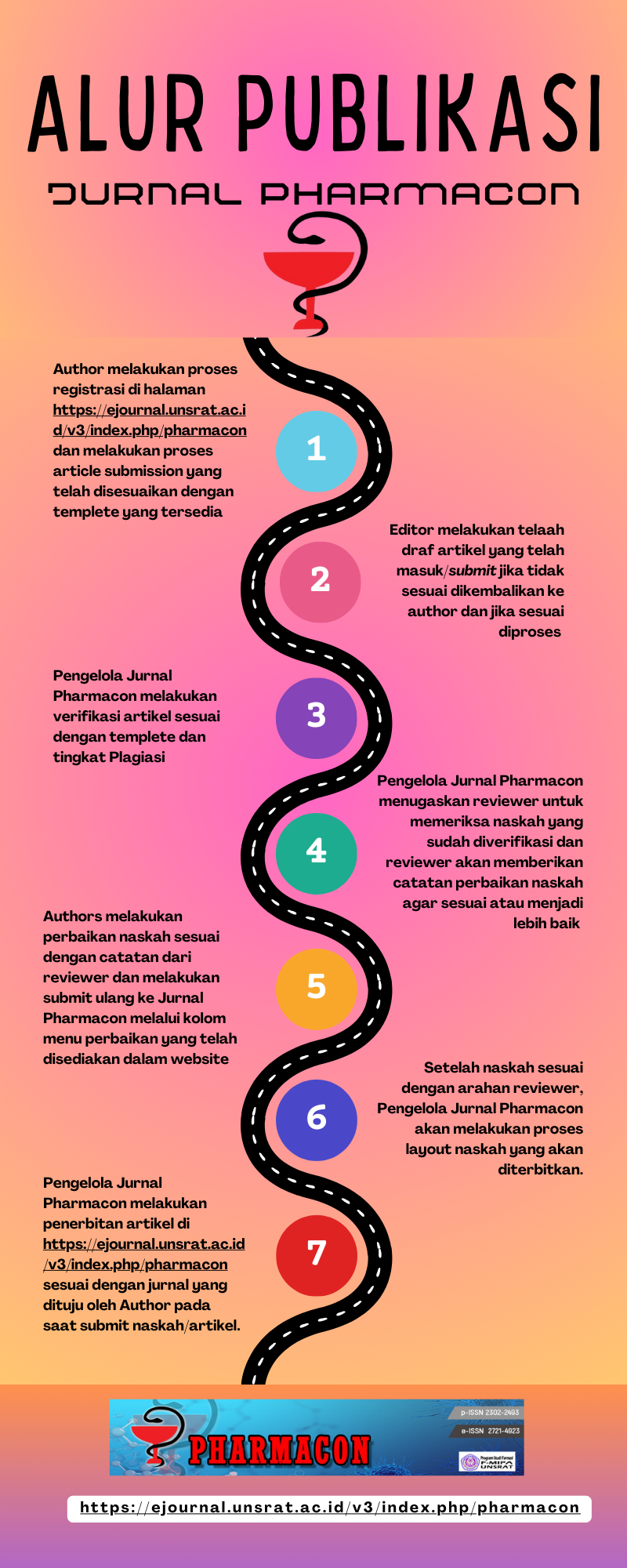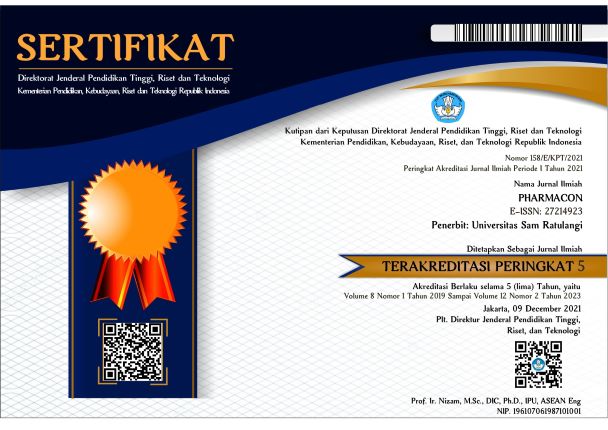ANTIOXIDANT ACTIVITY TEST OF ETHANOL EXTRACT (Polycarpa aurata) OBTAINED FROM THE WATERS OF POOPOH VILLAGE, MINAHASA REGENCY
DOI:
https://doi.org/10.35799/pha.13.2024.49459Keywords:
Polycarpa aurata, Antioxidant, DPPH, Poopoh Village, Minahasa RegencyAbstract
One of the potential marine ingredients that are needed in the fields of food, cosmetics and health is as a source of antioxidants. Antioxidants inhibit the decay of certain substances, reduce oxidative stress, inhibit cell aging, and ward off free radicals. One marine organism that has potential as a natural antioxidant is Tunikata Polycarpa aurata. This study aims to test the antioxidant activity of Polycarpa aurata ethanol extract obtained from the coast of Poopoh Village, Minahasa Regency. The test uses the DPPH method with concentrations of 25 ppm, 50 ppm, 75 ppm, and 100 ppm to analyze antioxidant activity using a spectrophotometer. The results obtained the greatest antioxidant activity in Polycarpa aurata with a concentration of 100 ppm with an average percent inhibition of 80.744%. The results of this study showed the antioxidant activity of Polycarpa aurata from the waters of Poopoh Village, Minahasa Regency has good antioxidant activity.
Keywords: Polycarpa aurata, Antioxidant, DPPH, Poopoh Village, Minahasa Regency.
References
Aulia, U. N. 2011. Eksplorasi Potensi Dan Fungsi Senyawa Bioaktif Ascidian Didemnum molle Sebagai Antifouling [skripsi]. Institut Pertanian Bogor. Bogor.
Frelinsia, Defny S. Wewengkang, dan Irma Antasionasti.2020. Uji Aktivitas Antioksidan Ekstrak Etanol Ascidian Herdmania Momus dengan Metode DPPH (2,2- Diphenyl-1-Picrylhydrazil). Jurnal MIPA. 9(3): 29-34
Heo, S. J., S. H. Cha., K. W. Lee., S. K. Cho. dan Y. J. Jeon. 2005. Antioxidant Activities of Chlorophyta and Phaeophyta from Jeju Island. Algae, 20(3): 251-260.
Huffard, C.L.; Erdmann, M.V.; Gunawan, T. 2012. Geographic Priorities for Marine Biodiversity Conservation in Indonesia. Ministry of Marine Affairs and Fisheries and Marine Protected Areas Governance Program: Jakarta, Indonesia.
Lambert, G. 2004. Relaxing, and Fixing Tunikata for Taxonomi. Departements edu. Washington.
Mardiyah, U., Fasya, G. A. Fauziyah, B., dan Amalia, S. 2014. Ekstraksi Uji Aktivitas Antioksidan dan Identifikasi Golongan Senyawa Aktif Alga Merah Eucheuma spinosum dari Perairan Banyuwangi. Jurnal Achemy. 3 (1): 42
Mosquera, O. M., Corea, Y. M. & Buitrago, D. C., Nino J. (2007). Antioxidan Activity of Twenty Five Plants from Colombian Biodiversity, Mem Inst Oswaldo Cruz, 102(5): 631-634
Moelyono, 2016. Farmasi Bahari. Yogyakarta. Deepublish.
Parwata, I. M. O. A., Wiwik, S. R., dan Raditya, Y. 2009. Isolasi dan UjiAntiradikal Bebas Minyak Atsiri pada Daun Sirih (Piper betle Linn) secara Spektroskopi Ultra Violet-Tampak. Jurnal Kimia. 3(1):7-13.
Schmidt, E. W and M. S. Donia. 2010. Life in cellulose houses: Symbiotic bacterial biosynthesis of ascidian drugs and drug leads. Curr Opin Biotechnol. 21: 827-833.
Shenkar, N., and Swalla, B. J., 2011. Global Diversity of Ascidiacea. Plos one. 6(6): 1-2
Sindhi, V., Gupta, V., Sharma, K., Bhatnagar, S., Kumari, R., Dhaka, N. 2013. Potential Applications of antioxidants—A review. J. Pharm. Res. 7(9): 828–835.
Winarsi. 2007. Antioksidan Alami dan Radikal Bebas. Yogyakarta: Kanisius.
Downloads
Published
How to Cite
Issue
Section
License
Copyright (c) 2024 Ath Thariq Fadhli Adhimul Ghanny Ghanny, Adhitya Yudistira, Julianri Sari Lebang

This work is licensed under a Creative Commons Attribution-NonCommercial 4.0 International License.
Authors who publish with this journal agree to the following terms:
- Authors retain copyright and grant the journal right of first publication with the work simultaneously licensed under a Creative Commons Attribution-NonCommercial 4.0 International License that allows others to share the work with an acknowledgement of the work's authorship and initial publication in this journal.
- Authors are permitted and encouraged to post their work online (e.g., in institutional repositories or on their website) prior to and during the submission process, as it can lead to productive exchanges, as well as earlier and greater citation of published work (See The Effect of Open Access)










